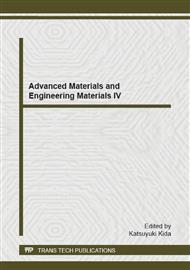[1]
Rosenthal, D., 1946. The theory of moving sources of heat and its application to metal treatments. Transactions of the American Society of Mechanical Engineers, Vol. 68, p.849 – 866.
DOI: 10.1115/1.4018624
Google Scholar
[2]
Wells, A. A., 1952. Heat Flow in Welding. Welding Journal, Vol. 31, n. 5, pp. 263s-267s.
Google Scholar
[3]
Adams Jr, C. M., 1958. Cooling rates and peak temperatures in fusion welding. Welding Journal, Vol. 37, n. 5, pp. 210s-215s.
Google Scholar
[4]
Chuansong, W., Zhenning, C., Lin, W., 1993. Numerical analysis of three-dimensional fluid flow and heat transfer in TIG weld pool with full penetration. Acta MetallurgicaSinica, Series B, Vol. 6, n. 2, pp.130-136.
Google Scholar
[5]
Kim, I. S., Basu, A., 1998. A mathematical model of heat transfer and fluid flow in the gas metal arc welding process. Journal of Materials Processing Technology, Vol. 77, pp.17-24.
DOI: 10.1016/s0924-0136(97)00383-x
Google Scholar
[6]
Wahab, M. A., Painter, M. J., 1997. Numerical models of gas metal arc welds using experimentally determined weld pool shapes as the representation of welding heat source. International Journal of Pressure Vessels and Piping, Vol. 73, pp.153-159.
DOI: 10.1016/s0308-0161(97)00049-5
Google Scholar
[7]
Hong, K., Weckman, D. C., Strong, A. B., 1998. The influence of thermofluids phenomena in gas tungsten arc welds in high and low thermal conductivity metals. Canadian Metallurgical Quartely, Vol. 37, n. 3-4, pp.293-303.
DOI: 10.1179/cmq.1998.37.3-4.293
Google Scholar
[8]
Wahab, M. A., Painter, M. J., Davies, M. H., 1998. The prediction of the temperature distribution and weld geometry in the gas metal arc welding process. Journal of Materials Processing Thechnology, Vol. 77, pp.2333-239.
DOI: 10.1016/s0924-0136(97)00422-6
Google Scholar
[9]
Fassani, R. N. S., 2001. Modelamento Analítico e numérico da transferência de Calor no Processo de Soldagem com Múltiplos Passes. PhD. Thesis, Universidade Estadual de Campinas, Campinas, SP. Brazil.
DOI: 10.47749/t/unicamp.2001.206671
Google Scholar
[10]
Gery, D., Long, H., Maropoulos, P., 2005. Effects of welding seed, energy input and heat source distribution on temperature variations in butt joint welding. Journal of Materials Processing Technology, Vol. 167, pp.393-401.
DOI: 10.1016/j.jmatprotec.2005.06.018
Google Scholar
[11]
Goldak, J., Chakravarti, A. Bibby, M., 1984. A new finite element model for welding heat sources. Metallurgical.
DOI: 10.1007/bf02667333
Google Scholar
[12]
Attarh, M. J., Sattari-Far, I., 2011. Study on welding temperature distribution in thin welded plates through experimental measurements and finite element simulation. Journal of Materials Processing Technology, Vol. 211, pp.688-694.
DOI: 10.1016/j.jmatprotec.2010.12.003
Google Scholar
[13]
Oliveira, F. R., 2011. Análise da influência dos parâmetros de refusão no ciclo térmico de revestimentos Fe-Cr-Mn-Si aspergidos e refundidos. Trabalho de Conclusão de Curso Bacharelado em Engenharia Mecânica, Universidade Tecnológica Federal do Paraná. Ponta Grossa, PR, Brazil.
DOI: 10.14488/encep.9786588212004.131-138
Google Scholar
[14]
Jhaveri, P., Moffat, W. G., Adams Jr, C. M. The effect of plate thickness and radiation on heat flow in welding and cutting. Welding Journal, v. 41, n. 1, p. 12s-16s, January (1962).
Google Scholar


